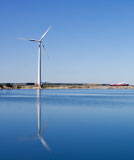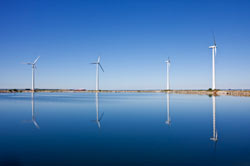
Catching Wind for Clean Water
Windmill-driven aeration is a winning option
 Attica, N.Y., and Seattle, Wash., both have found success in accomplishing their goals using aeration powered by wind energy.
Attica, N.Y., and Seattle, Wash., both have found success in accomplishing their goals using aeration powered by wind energy.
Attica's water department caught onto wind power almost nine years ago. The 8.5-acre reservoir there, which holds approximately 50 million gallons of water, was contaminated by naturally occurring iron and manganese.
Brian Krawczyk, chief operator at the Attica Water Plant, explained that his team used to treat the problem with water and chlorine but that process caused red water problems and constant turbidity.
The plant also had used copper sulfate at the reservoir as an algaecide until the Department of Environmental Conservation issued new regulations on its application due to potentially toxic effects on fish, swimmers, and the surrounding habitat.
"We did quite a bit of exploration on the 'Net, and aeration appeared to be the best solution," Krawczyk says.
Constructed in 1928, the Attica reservoir is fed by the surface waters of Crow Creek and is located in a wooded area. The location made running power to an electric aeration device problematic, although the water department wanted to avoid the cost of energy anyway.
"In the process of researching aeration, I came across the Koenders Windmill Web site (the parent company of Superior Windmills, Regina, SK Canada)," said Krawczyk. "The wind power aeration solution has made us think differently. I had started researching water problems stemming from iron and manganese, and aeration kept reappearing as one of the best ways to take care of the problem. So we decided to pursue it."
Krawczyk said the simplicity of the windmill aeration system was impressive: easy to build and self-install, relatively few parts, little maintenance, and no electric power.
"The windmill aeration system couldn't be a simpler design," Krawczyk said. "The wind creates a rotary motion that is converted by the windmill to a reciprocating motion. It pumps a diaphragm and that pumps air into the reservoir. So, it appeared to be a perfect fit for us."
Before making a final decision on the windmill, the department had to come to terms with height and footprint issues.
"The reservoir is sheltered by trees," explained Krawczyk. "We had to keep the windmills at a relatively low height (12 feet) so that we could catch the air currents as they move across the water. Even though the reservoir is located in a bowl and there is not a whole lot of air moving in the area, just a relatively light breeze will keep the windmills spinning."
The other problem was that the reservoir is contained by an earthen dam that is fairly narrow, so the windmill must have a relatively small footprint. The bigger the windmill tower, the bigger the footprint, so the 12-foot tower was a good solution for both footprint and height.
The Attica water department purchased five windmill aeration systems. Three were installed at the primary reservoir, and one for standby. The fifth windmill was eventually disassembled and converted to a water wheel that continuously flows and aerates water at a secondary reservoir.
Krawczyk seems to be satisfied with the systems' performance.
"We seldom run into any repairs," he said. "We just grease the pivots each year. We recently replaced the diaphragms and check valves, which was simply routine service. We will probably go for two to three years without having to service them again."
Seattle solution
At the Interbay Golf Center in Seattle, a combination golf course, driving range, and other recreational complex, a 15,000-square-foot pond has algae problems throughout the summer months. The pond is a relatively shallow water retention facility that also is a wildlife shelter that, along with the course, is registered with the Audubon Sanctuary Program.
"To protect the habitat, we are trying to get away from using chemical treatments like copper sulfate and herbicides," explained Rocky Tharp, golf course superintendent. "We built this pond as a small ecosystem that is part of an environmental case study. So we don't want to be spraying ducks and geese with copper sulfate."
Tharp said his crew has tried "beneficial organisms" as an alternative to chemicals but has not had much luck with them. Since the pond was built it has become a magnet for ducks and other birds. The waste from them has rapidly contributed to the growth of algae. Tharp thought that sufficient oxygen would overcome any algae problems and help to reduce sludge on the bottom of the pond.
"So, in addition to increasing the pond biodiversity and adding oxygenating plants, we have decided to try some type of aeration system. But, of course, the electric-powered aerators can be expensive to purchase and install, especially if you don't have a nearby power source," Tharp explained. "So, we decided to try the Superior Windmill aeration system because it is relatively inexpensive, costs nothing to operate, and will have less environmental impact."
Superior Windmill offers windmill aeration system models from 12- to 20-feet high with hub and compressor pre-installed. Volumes of air flow produced depend on the model but range from 1.5 cfm at 9 mph to 180 cfH or 3.0 cfm at 9 mph.